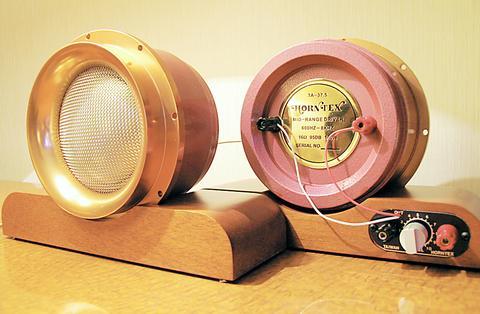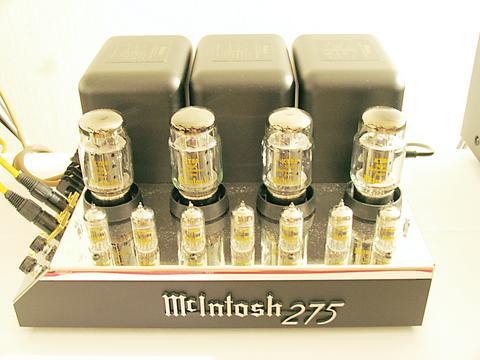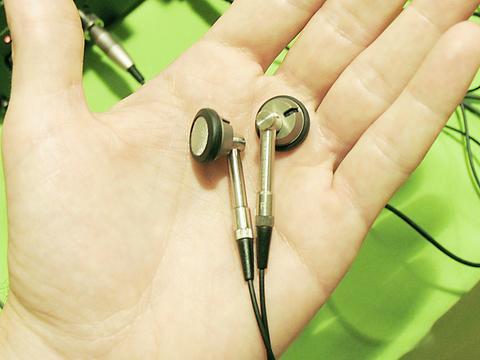Audiophiles must check out Taiwan Audio Association's (TAA) International Hi-End Hi-Fi Show taking place at the Holiday Inn AsiaWorld through 5pm tomorrow -- and leave your wallet at home.
TAA has taken over five floors of the hotel and put an exhibitor in nearly every room on each floor. It's like the world's biggest hotel room-hopping party only without the beer, chips and dip. The reason the association chose to house their convention in rather unconventional quarters is obvious as soon as you walk in any of the rooms. Each is stacked floor-to-ceiling with the latest in hi-end hi-fi and home theater equipment. Trying to demo some of these mammoth speakers and amps in an exhibition hall setting would surely spark a stereo war of deafening proportions. Better, then, to put thick walls between the exhibitors and hire cute girls to walk the halls listening for sound systems that get out of hand.

PHOTO: DAVID MOMPHARD, TAIPEI TIMES
And get out of hand they easily can. Step into the sixth-floor room that's been outfitted with a single McIntosh XRT30 loudspeaker system and you might think Phil Specter has set up his famous Wall of Sound in miniature. Well, miniature by degrees. The XRT30 system is actually four units; two bass units and two towers. The bass units each carry two, 12-inch ultra-low distortion long-throw throw woofers and the ceiling-high towers pack 30, four-inch mid-range drivers and 25 high-end tweeters each. The system is big enough to demand that each channel be powered independently and, for the exhibition, they've been plugged into a pair of 1,000-watt McIntosh amps. The covers have been removed from the towers to show off an array of 55 speakers. Just seeing it before the music comes over can make you think twice about how close you want to stand.

More than raw power, talk among the exhibitors is of sound "image," or how the sound would appear to sit in the room with you. Poor speakers have a flat image, that is, all the sound seems to come simply from the front of the panel. Close your eyes and spin around and you'll always still be able to point to where the music is coming from. This isn't done so easily at TAA's show. What you get here is a lesson in what excellent sound image can be -- and how some big speaker systems can actually produce a rather flat image.
For instance, while McIntosh's XRT30 has enough independent speakers to produce a full image, Laurence Liao's (

(Classical music fans, give a listen. Many exhibitors are selling compact discs of symphonic recordings on the cheap. They'll likely be cheaper come tomorrow, the last day of the exhibit.)

Liao is one of several Taiwanese acousticians whose products are on display and hearing their various loudspeaker systems offers the exhibit's other great lesson: why hi-end audio often isn't high-tech audio.
Hung Renn-yow (
"I make 2,000 tweeters and 2,000 mid-range speakers every year by myself," he said. "I make 500 woofers and hundreds of amps every year -- just one man!"
The only thing Hong does not make, he claims, is source equipment such as CD players or tuners. He brings out a piece of speaker paper from his travel case and places it on a table.
"I make this paper myself," he says.
He takes out the small driver of a mid-range speaker and its thin tin covering, too.
"I make this myself," he says.
He places his hand on the meter-wide horn of the woofer that fills most of the room. He made that, too.
"Hi-end audio isn't about high-technology," Hong said. "It's about design and craftsmanship. `Sun Yat-sen said: things aren't expensive, skill is expensive. (
Indeed, with all the vacuum-tube amps that look like relics from the 1960s and cherry-wood speaker cabinets, it would seem that audio technology has evolved little in the past half century. In fact, it hasn't.
Following the consumer-electronics boom of the 1980s which sold billions in solid-state audio equipment, musicians and audiophiles began missing the particular distortion and speaker-dampening characteristics of tube equipment. Among guitar players, the most sought-after and highest-priced amps are modern versions of Fender, Marshall and Vox amps from the 1950s and 1960s, thought to have generated some US$100 million in sales since 1997.
The trend now, it seems, is to employ the craftsmanship and quality materials of yesteryear in updated designs. A pair of NT$9,000 Audio-Technica earbuds are a good example of this. They essentially duplicate the same speakers Hong makes in titanium miniature. Do they sound better than NT$900 earbuds you might buy at a record store? Yes. Do they sound NT$8,100 better? Check out TAA's show and decide for yourself.

On April 26, The Lancet published a letter from two doctors at Taichung-based China Medical University Hospital (CMUH) warning that “Taiwan’s Health Care System is on the Brink of Collapse.” The authors said that “Years of policy inaction and mismanagement of resources have led to the National Health Insurance system operating under unsustainable conditions.” The pushback was immediate. Errors in the paper were quickly identified and publicized, to discredit the authors (the hospital apologized). CNA reported that CMUH said the letter described Taiwan in 2021 as having 62 nurses per 10,000 people, when the correct number was 78 nurses per 10,000

As we live longer, our risk of cognitive impairment is increasing. How can we delay the onset of symptoms? Do we have to give up every indulgence or can small changes make a difference? We asked neurologists for tips on how to keep our brains healthy for life. TAKE CARE OF YOUR HEALTH “All of the sensible things that apply to bodily health apply to brain health,” says Suzanne O’Sullivan, a consultant in neurology at the National Hospital for Neurology and Neurosurgery in London, and the author of The Age of Diagnosis. “When you’re 20, you can get away with absolute

May 5 to May 11 What started out as friction between Taiwanese students at Taichung First High School and a Japanese head cook escalated dramatically over the first two weeks of May 1927. It began on April 30 when the cook’s wife knew that lotus starch used in that night’s dinner had rat feces in it, but failed to inform staff until the meal was already prepared. The students believed that her silence was intentional, and filed a complaint. The school’s Japanese administrators sided with the cook’s family, dismissing the students as troublemakers and clamping down on their freedoms — with

As Donald Trump’s executive order in March led to the shuttering of Voice of America (VOA) — the global broadcaster whose roots date back to the fight against Nazi propaganda — he quickly attracted support from figures not used to aligning themselves with any US administration. Trump had ordered the US Agency for Global Media, the federal agency that funds VOA and other groups promoting independent journalism overseas, to be “eliminated to the maximum extent consistent with applicable law.” The decision suddenly halted programming in 49 languages to more than 425 million people. In Moscow, Margarita Simonyan, the hardline editor-in-chief of the